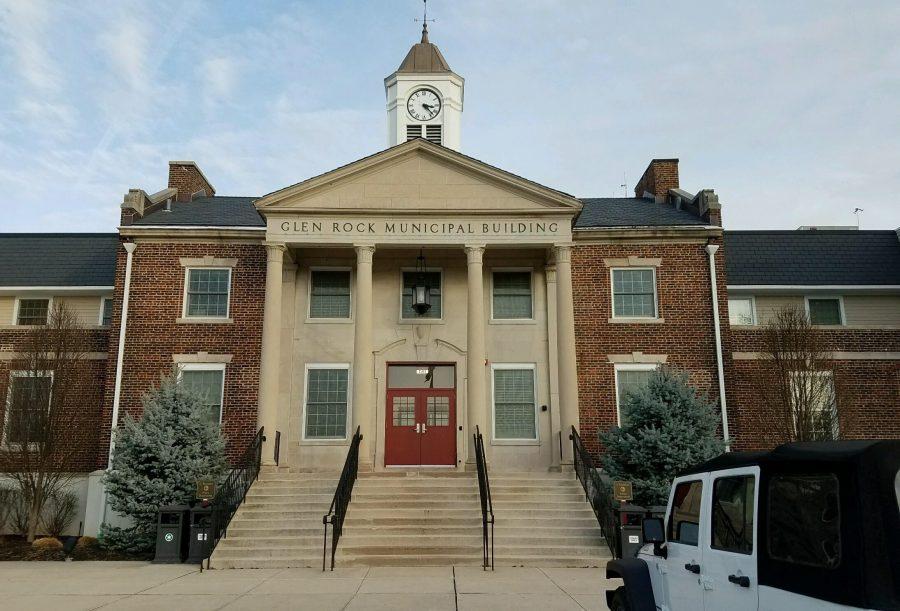Glen Rock borough discusses affordable housing
Photo Credit: Isis Kirkland
Glen Rock Municipal Building, where the zoning department work session took place. Borough members and residents gathered to discuss plans for affordable housing units.
January 12, 2017
Zoning department members and Glen Rock residents gathered to discuss affordable housing options last week in Borough Hall.
The Glen Rock Zoning and Planning Department held the work session on Jan. 5 at 7:30 p.m.
Affordable housing has been mentioned in the news recently in regards to New York City. While other cities have had experience with it, Glen Rock has very little. The only affordable housing Glen Rock has seen was Glen Rock Square, which has since been bought out.
“Effectively what we are looking at is what’s called a realistic opportunity for the production of affordable housing. Every municipality has an obligation based upon the courts in various legislative decisions to have a realistic opportunity for affordable housing. So, every community within New Jersey has to deal with that,” Principal of Burgis Associates, Inc., Edward J. Snieckus said.
Affordable housing supplies homes that are within the budgets of those whose income is below the median household income. Affordable housing units are important to families because they provide shelter at a reasonable price. Affordable housing units can make a community thrive because the units attract employees who are looking to live closer to their jobs.
An explanation of affordable housing laws
While most are familiar with the concept of affordable housing, few know the laws and legislation behind it. Affordable housing is a process with many steps, rules, and agencies supporting it.
The agency that handles most situations with affordable housing is the Council on Affordable Housing (COAH). COAH was responsible for creating rules, the regional need numbers and methodology, as well as certifying plans. The Council on Affordable Housing was established under the Fair Housing Act. They then changed the rules from fair share of regional need to growth share. Growth share basically details that if a community is growing, a certain amount of that growth needs to be affordable housing. Organizations objected to that approach, as they found it quite problematic. These agencies and organizations felt like it was not going to achieve a reasonable amount of a fair share of affordable units.
“Through a series of litigation and court proceedings, they discussed the fact that it’s problematic and in 2013 the courts ruled that growth share was not appropriate. They then implored the Council on Affordable Housing to come up with new rules,” Snieckus said. “From 2013 to effectively March of 2015, COAH tried and was unsuccessful with creating new rules that would lead to an unchallenged approach to establishing affordable housing need numbers. So, March of 2015 the Supreme Court ruled that COAH was ‘effectively ineffective’ in establishing new rules, and pulled the requirements from COAH, back to the courts for review of applications for certifications of boroughs and municipalities housing need numbers.”
How affordable housing might work in Glen Rock
Glen Rock is a small town, so space to build these units could be a potential problem. There are limited options available for construction of the affordable housing units.
“Glen Rock would need to seek what’s called a vacant land adjustment. With this, the town is able to utilize environmental restrictions such as floodplains, wetlands, steep slopes, and things of that nature to apply to any vacant land available, to see if in fact that it has a realistic development potential,” Snieckus said. Redevelopment is also an option. Snieckus gave the example that if there is a large empty parking lot somewhere in Glen Rock, it could potentially be redeveloped into a zone for the affordable housing units.
If the units are built, then the income threshold will be based on region and the cost of living within the region. The housing units could be rented or purchased. There will be a 15 percent set aside for those planning to rent, and a 20 percent set aside for those looking to buy. There is no exact ballpark estimate on the income level that someone would need to rank eligible for the units. However, the income level will be based on the size of the family interested, as well as three categories of very low, low, and moderate income.
“I think it will be a nice addition,” Glen Rock resident Charis Greene said. “Everybody deserves a chance to live in a nice community and in a good environment. No matter what their incomes are. Everyone deserves to have that.” Greene has been a Glen Rock resident for 30 years and knows about affordable housing through friends that live in affordable housing units. She believes that affordable housing units would be great for Glen Rock, so that those who are looking to live in the units will have access to a great school system.
Glen Rock must figure out an affordable housing plan quickly to prevent a builder’s remedy lawsuit, however.
A builder’s remedy lawsuit is when a municipality hasn’t planned for and hasn’t enacted a plan to establish their fair share, or address their fair share for affordable housing that’s assigned. These municipalities essentially leave themselves open to litigation, that accuses them of ignoring the subject by not having a plan in place. Snieckus isn’t ignoring this, and would like to submit a declaratory judgement to participate in this process.
“They (the courts) can submit that litigation based on the fact that a community has not planned for, and chooses to ignore the affordable housing requirements. That’s why it’s very important to plan for it. Nobody wants to be in that situation, because it may not be just one developer. Then there aren’t rules in place or zoning in place to control the level of development,” Snieckus said.
When affordable housing began
Affordable housing started in 1975 with the Mount Laurel 1 decision.
“A woman was trying to convert some chicken coops in the back of a large estate to apartment units, and the mayor at the time (of Mount Laurel) said ‘you know what, that’s in a one acre zone, we don’t want to see that type of density in that location. If you can’t afford to build a house on a one acre lot, it shouldn’t be there, it should be somewhere else’,” Snieckus said.
This woman went on to meet with the Camden Legal Aid Services and had the NAACP take on the case. The NAACP challenged the town’s decision to not permit effectively, and bar through zoning, affordable units to be built in a community. “What that lead to was the courts actually deciding all the way up to the superior court what’s called the Mount Laurel 1 decision in 1975. And in that decision which is 276 pages, they identified that every developing municipality has a constitutional obligation for fair share of affordable housing,” Snieckus said.





Mark Graham • Jan 14, 2017 at 10:52 am
This is a very well written article explaining the affordable housing issue.
I applaud the writer for bringing this important issue to the the public”s attention. Time and time again I”ve been discouraged by the push to keep certain parts of the population from bettering their lives. Human decency and a sense of civic responsibility dictate that all people should be able to enjoy a reasonable place to raise their families in this country. After all, we all want better live for ourselves and for our children. Communities and characters thrive when everyone is given the opportunity for a better life.